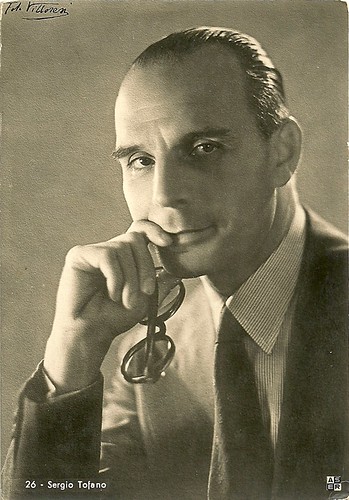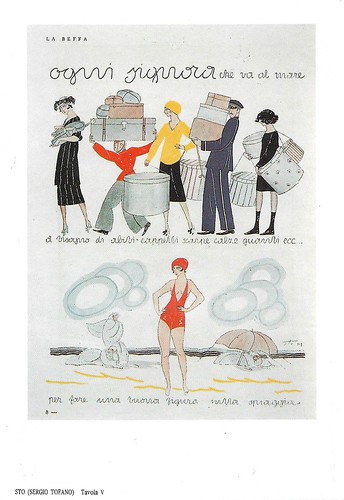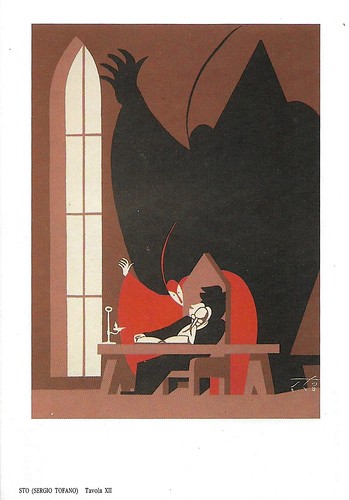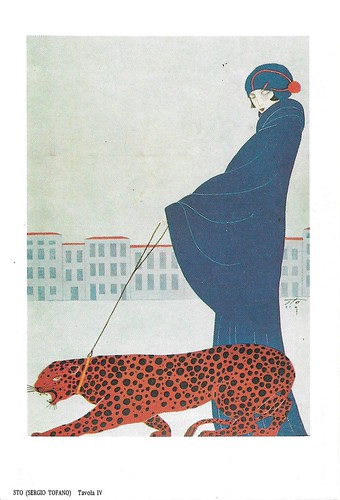
Italian postcard in the Series Cines-Pittaluga, Rome, no. 2556.

Italian postcard by Ed. Art. Alberani. Painting: Nanni. Behind Tofano the character of Signor Buonaventura, Tofano's creation.
Creator of Signor Bonaventura
Sergio Tòfano was born in Rome, Italy, in 1886.
In 1909, he made his first appearance on stage with Ermete Novelli, then joined Virgilio Talli's company (1912–23). He soon specialised as a comic actor, giving his role a new elegance and complexity.
He interpreted works of multiple authors going from Molnár to G.B. Shaw, from Jules Romains to Luigi Pirandello, from Machiavelli to Molière, from Anton Checkov to Henrik Ibsen, Kaiser, an Bertolt Brecht.
In 1917 Sergio Tòfano invented, for a children's magazine, Il Corriere dei Piccoli, a famous character, Signor Bonaventura, whose adventures lasted for more than forty years. He used to sign as Sto. He wrote and illustrated several children's books and illustrated 'The Chess Set in the Mirror' by Massimo Bontempelli.
In 1924-1926, Tofano worked with the director and playwright Dario Niccodemi, and in 1927-1930 with Luigi Almirante and Giuditta Rissone, co-acting with Elsa Merlini, Vittorio De Sica, Evi Maltagliati, Gino Cervi, and many others.
During those years, he made his memorable performances as Doctor Knock in Jules Romains' homonymous play, and as Professor Toti in Luigi Pirandello's 'Pensaci, Giacomino!'. He also led important theatrical firms. After the Second World War, he worked with the most important innovative stage directors such as Luchino Visconti and Giorgio Strehler.

Italian postcard by ASER (A. Scarmiglia Ed., Roma), no. 26. Photo: Villoresi.

Italian postcard by B.F.F. Edit., no. 4270. Photo: Bragaglia.
Stealing the show in The Cherry Orchard
After a one-off performance in the silent film Tigrana (Edouard Micheroux de Dillon, 1916), Sergio Tòfano's film acting career really set off with his part of the usher Otello in the comedy La segretaria privata/The Private Secretary (Goffredo Alessandrini, 1931), starring Elsa Merlini and Nino Besozzi.
Many other comedies at Cines-Pittaluga followed in the early 1930s, such as La telefonista/The Telephone Operator (Nunzio Malasomma, 1932) with Isa Pola and Paprika (Carl Boese, 1933) with Elsa Merlini, while he had the lead in O la borsa, o la vita/Your Money or Your Life (Carlo Ludovico Bragaglia, 1933) and in Seconda B (Goffredo Alessandrini, 1934).
Over the years, Tofano would work with a wide range of directors such as Mario Mattoli, Luigi Comencini, Pasquale Festa Campanile, Nanni Loy, Bernardo Bertolucci and Mario Monicelli.He would also direct two films, Cenerentola e il Signor Bonaventura/Princess Cinderella (1941), based on the characters of his popular comic strip series Signor Bonaventura and shot at the Pisorno studios in Tirrenia, and Gian Burrasca (1943).
From the start of television in Italy, Tofano acted in teleplays in the 1950s and 1960s such as Orgoglio e pregiudizio/Pride and Prejudice (1957), L'idiota/The idiot (1959), Mastro don Gesualdo (1964), Il conte di Montecristo/The Count of Monte Cristo (1966), I promessi sposi/The Betrothed (1967), Le mie prigioni/My prisons (1968), after the eponymous novel by Silvio Pellico, and I fratelli Karamazov/The Brothers Karamazov (1969), plus two performances in the crime series Le inchieste del commissario Maigret/The Investigations by Commissioner Maigret (1965-1968).
Sergio Tòfano married actress Rosetta Cavallari (1902-1960) in 1923. They had a son, Gilberto Tofano, later a stage and TV director. In 1953 Tofano started teaching at the Roman theatre academy. After his retirement in 1960, he continued to teach and to play parts on television. In the same year, his wife, who suffered from depressions, killed herself. In 1973 Tofano died himself, in Rome, at the age of 87. He was buried at the family tomb in Milan, next to his wife.
In his text on Tofano, Sergio Romano remembered in Corriere della Sera (2012), how impressive Tofano's part had been of the old servant Firs in the final scene of 'The Cherry Orchard', directed by Luchino Visconti in 1965, one of Tofano's last stage performances. "But on the almost empty stage appeared Firs, forgotten by those to whom he had dedicated his life. In those few last minutes, while laying down on a sofa, he remembered the past and mumbled his last sentences. Tofano stole the show from Paolo Stoppa, Rina Morelli, Massimo Girotti, Lucilla Morlacchi, Ottavia Piccolo. At that moment the applause and some tears too were all for him."

Italian postcard by Stampa alternativa nuovo equilibri, Tavola V. Reprint of an old magazine illustration by Sto (Sergio Tofano) 'Ogni signora che va al mare [a bisogno di abiti, cappelli, scarpe, calze, guanti ecc. per fare una nuova figura sulla spiaggia]', Satana-Beffa 22, Milano 1919.

Italian postcard by Stampa alternativa nuovo equilibri, Tavola XII. Reprint of old magazine illustration by Sto (Sergio Tofano), 'Faust', in Il Cantastorie di Campari, Milano, 1928.

Italian postcard by Stampa alternativa nuovo equilibri, Tavola IV. Reprint of old magazine illustration by Sto (Sergio Tofano), 'Lady with leopard', in Lidel 17, Milano 1919. The picture must refer to fashion icon Marchesa Luisa Casati who lived in Venice between 1910 and 1919 and famously posed with a pet leopard.
Sources: Lungomarecastiglioncello, Wikipedia (English and Italian), and IMDb.
No comments:
Post a Comment